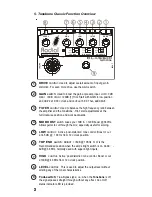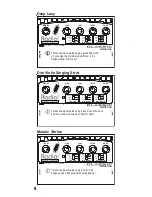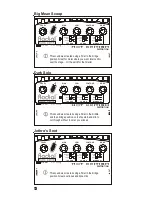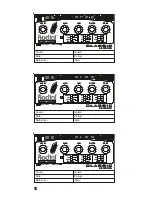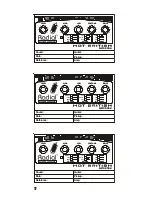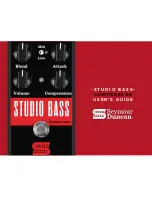
2. Unpacking your Tonebone:
Your Radial
Tonebone
pedal has been thoroughly tested at the
factory, and comes with a 15VDC power supply and this owner’s
manual. We recommend that you keep the box and original
receipt in the unlikely event that you should need to send the
unit back for servicing.
3. Powering up and getting connected:
Before you start, turn your guitar amp volume down to zero.
Tonebone
comes equipped with a special 15VAC power adapter
with enough power to drive the 12AX7 tube inside. When the power
suppy is connected, the
Tonebone
will be in standby mode. Like all
tube amps, for best tone let your
Tonebone
warm up for 5
minutes so that it achieves electrical and thermal stability. The
LED on the unit lights up when the foot switch is depressed to
indicate it is powered up and ready for use.
4. Using Tonebone – The starting point:
Start with all the controls at 12 o’clock and switches set to the
off or flat position. Turn your amp up to a comfortable listening
level and adjust the LEVEL output control for unity gain, i.e.: the
level with
Tonebone
on (LED is on) matches the level with it off
(LED off). Now start turning knobs!
You will find that most of the controls are intuitive and extremely
sensitive to changes. In other words, small control changes will
make big changes in the sound. Take your time and experiment.
It is important to note that both the
Tonebone
Classic and the
Tonebone
Hot British are ultra-high gain devices that have been
designed to provide ‘over-compensation’ control on all functions.
What this means is that each control when set to maximum is able
to compensate for other controls that may be completely backed
off. For instance, you may have your LEVEL wide open and your
DRIVE almost fully off. This gives you maximum flexibility but also
opens the door to over-saturation, which could lead to
uncontrollable feedback. To safeguard against this, you should
never drive all functions to maximum.
At the back of this manual are a number of setups for popular
sounds for both
Tonebone
models. Note that you will have to
tweak the settings shown on the setup chart to match your
specific guitar and amp set up.
In addition to the factory sound charts, a number of blank user
setting charts are included at the back of this manual.
Photocopy these handy charts and use them to save your own
‘found sounds’. Once you get a sound you like, chart the knob
positions and guitar/amp/pickup setting. These setup charts will
aid in you in getting familiar with the controls of your new
Tonebone
, and help in quickly recreating your exact sounds in
the studio.
Now Go Play!
2




